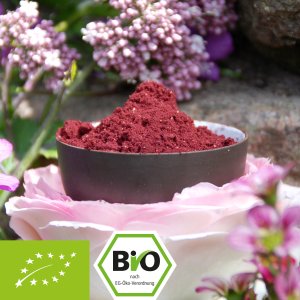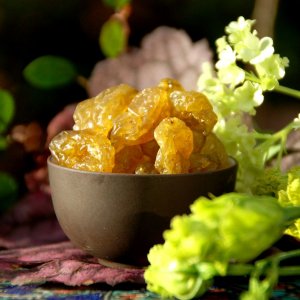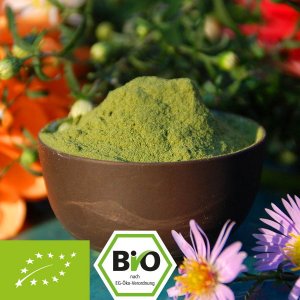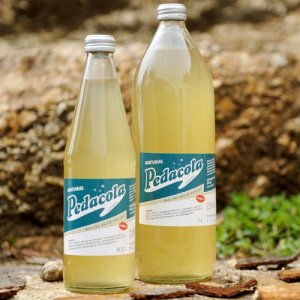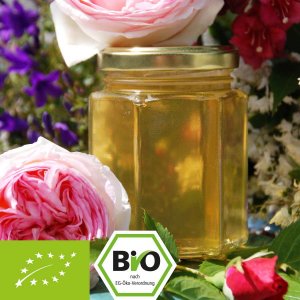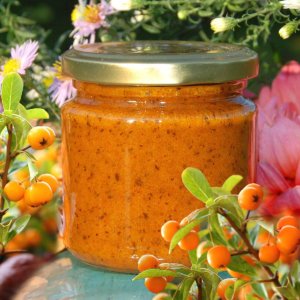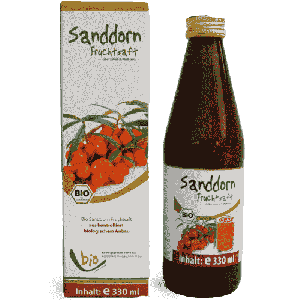Native superfoods and edible wild plants - Part 1 - rowan, sloe, sea buckthorn and rosehip
While nowadays we increasingly know and appreciate supra-regional superfoods, such as Spirulina, Chlorella, Moringa or Maca, the knowledge about the local edible wild plants is increasingly forgotten.
Nature on our doorstep often offers us a rich treasure trove of edible, tasty and nutrient-rich plants, quasi native superfoods. Often, incorrect knowledge about the edibility of plants also keeps us from harvesting them.
Of course, this is also due to the fact that harvesting and processing often involves a lot of effort.
We present here some local superfoods that you can easily collect and process yourself.
Of course, this is not an exhaustive list and you are welcome to share your suggestions and knowledge about other plants. Just write to us at. We are happy about every letter.
We'll start with my personal favorite, the 1997 Tree of the Year, the rowan tree or mountain ash:
Mountain Ash - native native plant and superfood for the cold season.
The rowan belongs to the rose family and, as the name suggests, is extremely popular with birds. However, it is usually only eaten after the first frost, as it is then soft and has already broken down bitter substances. The rowan is a rich source of food for many birds during the cold season. Among others, blackbirds, thrushes, robins and starlings are very fond of them.
Unfortunately, this fact was also the birds' downfall in earlier times, as the berries were often used as bait.
- Mountain ash berries - superfood for a healthy diet:
Among people, rowan berries are rather disreputable as they believe that the berries would be poisonous. However, this actually does not correspond to reality. The berries of rowan are in fact non-toxic. However, since they contain a large amount of tannins and bitter substances, as well as parasorbic acid, some people do not tolerate them well in their raw state. This can be remedied by processing, as the parasorbic acid is converted to the harmless sorbic acid by heating, and you can benefit from the vitamin C and polyphenols, which are also abundant and act as antioxidants.
Research has found that rowan berries often have the same or even higher levels of polyphenols as blueberries.
So rowan berries are indeed a true wild and local superfood.
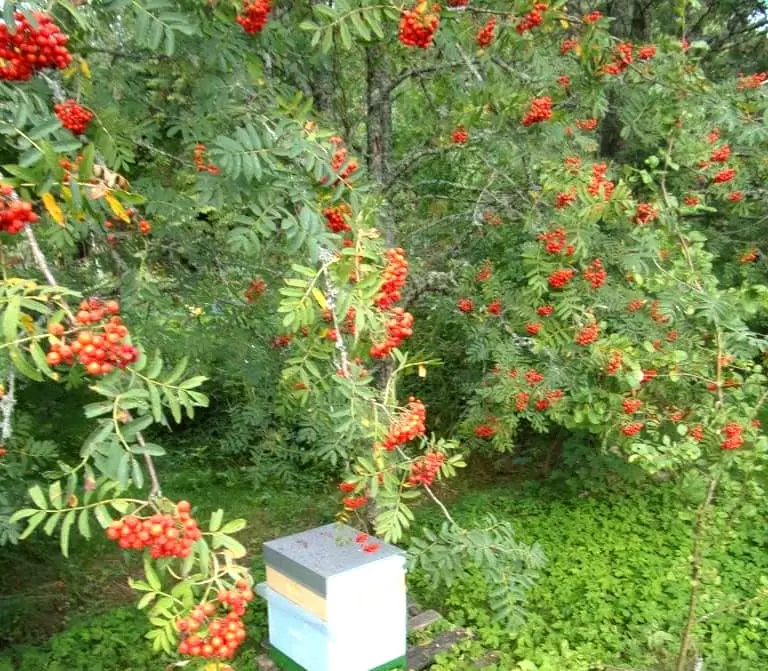
Rowan berries over beehive
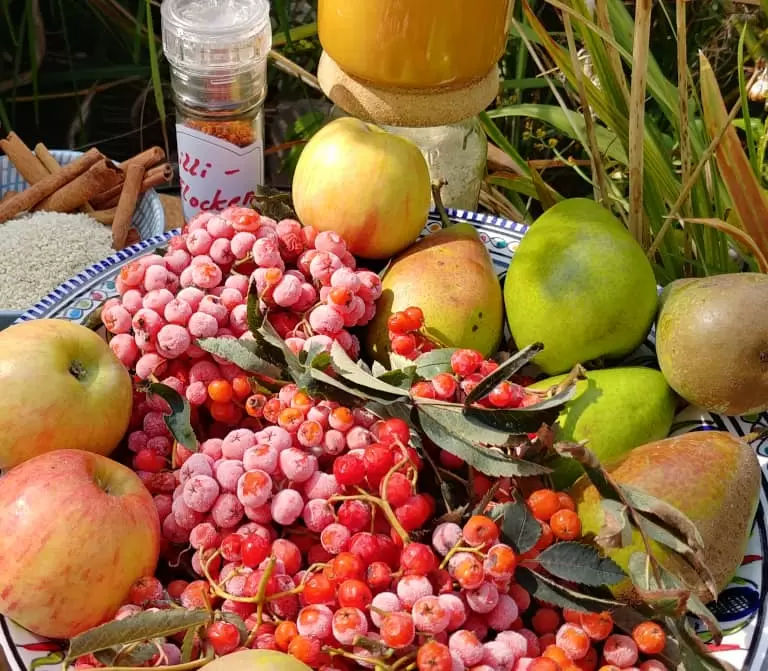
Frozen rowan berries
Rowan berries can be made into delicious chutneys or jams, by connoisseurs of the tart taste. Traditionally, the berries were also used to prepare liqueurs.
To do this, it is first necessary to harvest the fully ripe berries. You can recognise a ripe fruit by its deep red colour, which it usually reaches from August to September.
After harvesting, the fruit should first be sorted out and cleaned properly and then placed in the freezer for 2-3 days.
It is important that the cleaning is done in advance, because after freezing the fruits are too soft and it is really no fun to clean them anymore.
After freezing, the processing can finally begin. For this we have already deposited a recipe for rowanberry chutney on our recipes page. We wish you a lot of fun while cooking. :)
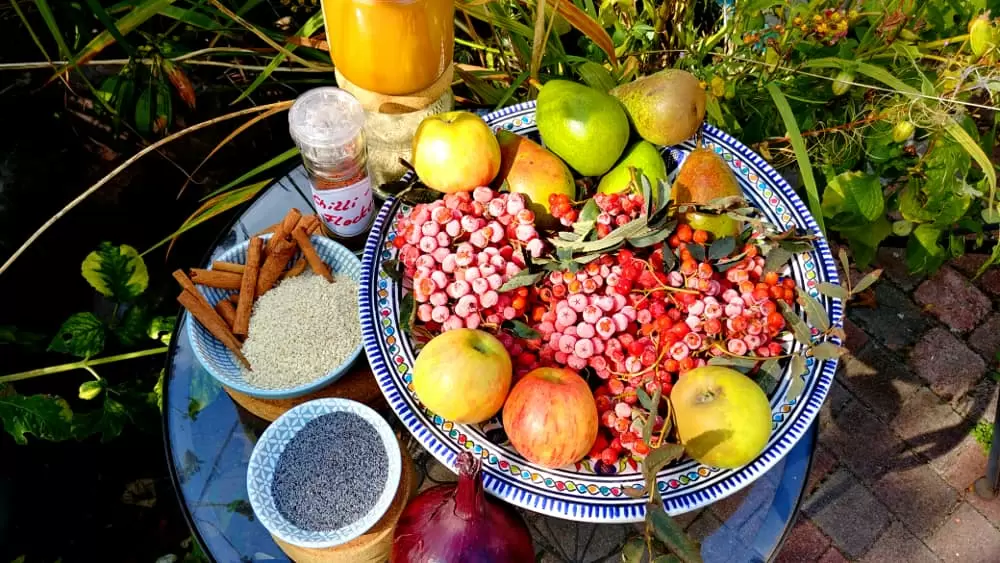

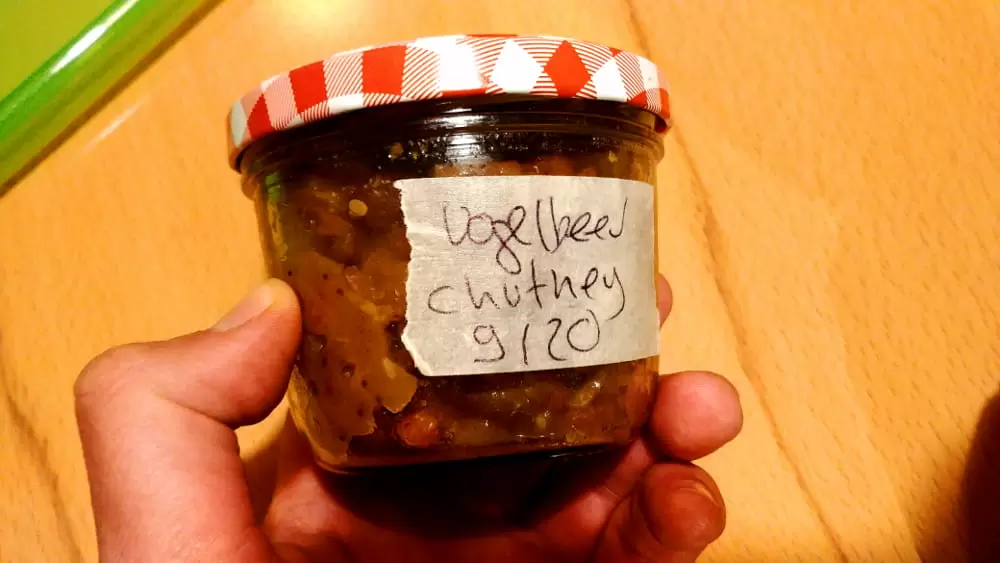
In former times the rowan found a much bigger use.
-
The mountain ash - historical facts and myths:
On the one hand, the rowan was very popular because, if it grew near a settlement, it was said to have protective properties. In this case, meticulous care was taken not to injure the tree.
Since the bark of the tree also has a high content of tanning agents, it was often used in tanning processes.
The wood, in turn, was very popular for carving, for making walking sticks and for making tool handles and spindles for spinning wheels because of its resistance.
The mountain ash has been the subject of a number of myths since time immemorial, as is often the case with many wild plants.
In Norse mythology, the first woman was created from a rowan tree and the thunder god Thor was able to save himself with the help of a rowan tree when he was swept away by a raging river.
Nowadays, despite its adaptability as a pioneer plant, the rowan is unfortunately threatened with extinction due to the restriction and alteration of its habitat.
Further detailed information can be found under the following links:
The mountain ash - general info
Trees threatened with extinction
Trees threatened with extinction
Staying with the rose family, we turn our attention to the blackthorn:
Blackthorn - a thorny superfood with a lot of character
Most people are probably familiar with blackthorn because of its widespread distribution.
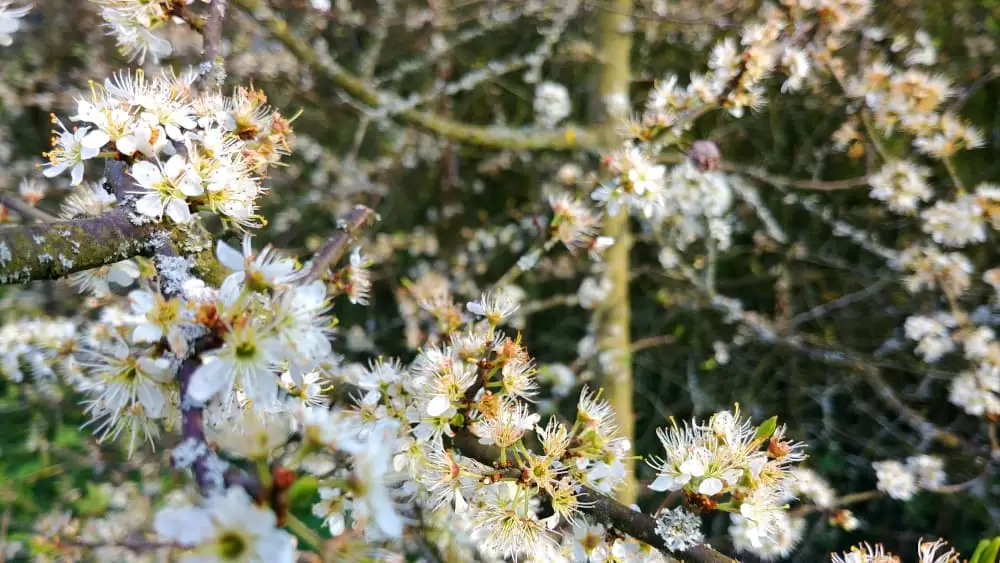
Blackthorn blossom
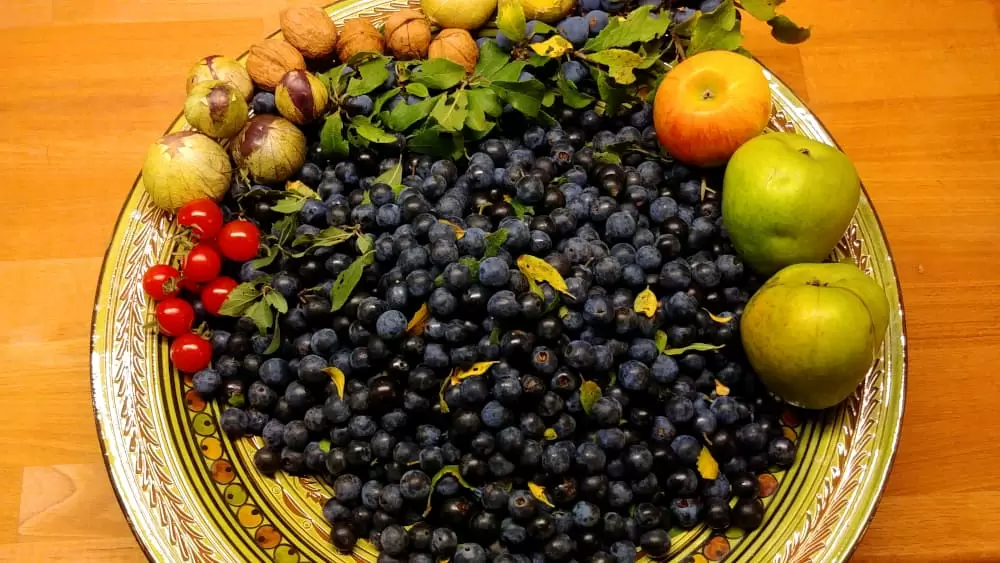
Blackthorn berries
It is often found along roadsides and fieldsides and in meadows in full sun, where it provides safe shelter for birds and smaller mammals due to its dense growth and extensive thorns.
These also contribute to the spread of blackthorn, as its fruits are equally popular with birds such as the red-backed shrike, barred warbler and nightingale. Mammals such as hedgehogs, brown hares and foxes also enjoy the ripe sloe fruit in late autumn or winter and thus carry the seeds of the sloe.
Blackthorn is also very important for insects that are active early in the year, such as the ground bumblebee, as it is an early flowering plant and therefore one of the first sources of food.
Bumblebees are extremely resistant to cold because their bloodstream contains a kind of antifreeze that prevents them from freezing to death during their winter dormancy. Because of this and their fur, they are able to become active well before other insects, sometimes even when the ground is still covered in snow.
This very successful Arte documentary provides detailed information on bumblebees and their way of life:
- Blackthorn - so useful and yet feared
According to old Celtic legends, not only birds, insects and other animals live in the blackthorn bush, but also a small race of fairies who protect the blackthorn bush and are not very friendly towards humans.
But there are also all kinds of other myths about the sloe bushes from ancient times.
From time immemorial, sloes have been associated with the so-called Cailleach, who in Irish folklore were seen above all as goddesses or fairies of the storm and winter.
Witches were said to have bewitched people with wands made of sloe wood.
So the shrub was said to have rather dark and sinister properties. This is certainly due to its long thorns and impenetrable growth.
Its growth habit and its hard heavy wood were also the reason why the wood of the sloe bush was extremely popular for the Irish shillelaghs, walking sticks made of sloe wood, which were also used for self-defence. Due to the hardness of the wood, they were a weapon not to be underestimated and were also used in traditional Irish stick fights.
You can find more exciting information about sloes in the following video:
Nowadays the sloes are known nevertheless rather because of rather their fruits, which might be enjoyed raw for most people nevertheless rather getting used to, since they are very strongly astringent and lose only in the fully ripe condition the strongly sour taste.
Thus, one should not suspect at first, what taste potential is in the berries. This only unfolds in the processed state.
-
Sloe - A delicious superfood for the kitchen:
You can process the sloe berries wonderfully to jam. During cooking, the taste does not change so much at first. But you shouldn't be put off, because from the moment you add the preserving sugar, the full aroma of the jam emerges and is strongly reminiscent of fully ripe plums.
This is not surprising, as the sloe is the wild ancestor of our present-day cultivated plums and damsons and probably originated by crossing with the equally wild cherry plum.
The recipe for our good sloe jam can of course also be found in our recipe section.
However, sloe berries are not only a tasty change but also not to be despised from a health point of view. Studies have found a high content of flavonoids and anthocyanins, making sloe a wild European superfood.
You can find more detailed information about sloe under the following > link.
Like the sloe, the sea buckthorn is also excellent for processing.
Which brings us to the next native superfood, the sea buckthorn.
The sea buckthorn - a golden shining native superfood
The sea buckthorn, lat. Hippophae rhamnoides, is an oil willow plant and a very special plant, because it is even more resistant than the blackthorn and has the ability to grow even under the most adverse circumstances and transform its environment.
More information can be found here:
- Soil preparation with sea buckthorn - a useful survivor:
Sea buckthorn is able to withstand extreme temperatures down to below -40 degrees Celsius and up to above +40 degrees Celsius without any problems and can also cope with extreme temperature fluctuations and extreme solar radiation. Dry and salty soils cannot harm it and it also defies salty sea air and strong storms.
It is therefore no wonder that the sea buckthorn is often found in inhospitable areas that have long since ceased to offer other plants any chance of growth, such as coastal and desert regions, scree slopes and other arid areas, up to an altitude of 5000m.
Like the mountain ash, the sea buckthorn is a pioneer plant and has the ability to prepare the ground for other plants.
Due to its extensive root growth, which can be up to 3m deep and 10m wide within 5 years, the sea buckthorn begins to consolidate the soil in its vicinity immediately after its growth, increasing the water permeability of the soil and thus also serving as a water reservoir.
With increasing growth, the buckthorn forms a quite stately and spreading crown, which in turn has the effect that falling heavy rain is not able to hit the ground unhindered and wash away the upper layers, wind is slowed down and sand cannot be blown away unhindered.
Thus, sea buckthorn begins to counteract soil erosion from the first moment it grows.
But that is not all, because the sea buckthorn has another special property.
The sea buckthorn plant is able to enter into a symbiosis with special bacteria, the Frankia alni, which belong to the nitrogen fixers, and thus to bind and enrich nitrogen in the soil and to form a humus layer through its leaf fall. The sea buckthorn thus helps other more demanding plants to settle in its environment, which in turn has the effect of stopping soil erosion.

Tit on sea buckthorn

Sea buckthorn berries with morning dew
Because of these special features, sea buckthorn is now receiving a lot of attention worldwide in anti-desertification programs, in the transformation of arid areas and in its use to stabilize coastal areas and steep slopes.
There are various projects in Chile, Mongolia, China and other parts of the world that are using sea buckthorn in an attempt to combat drought, desertification and erosion.
The DesertSpring project in Chile is one of these projects and tries to establish sea buckthorn plantations nationwide, as Chile is one of the South American countries that is particularly affected by dryness and drought. 70% of the Chilean population lives in such areas, according to a report in the Neue Zürcher Zeitung.
The Atacama Desert in northern Chile is emblematic of extreme drought.
A similar attempt was made by the Onggi River Movement in Mongolia at the Onggi River and here also first successes were shown. Here, a total of about 30 hectares of land were planted with buckthorn bushes and willows in order to bring the dried up river back to flow, which was acutely threatened by intensive mining operations.
In the northwest of China there are in some regions, like Inner Mongolia, wide areas which have to fight with extreme sandstone erosion.
Here, the planting of sea buckthorn bushes has been successful and has been able to significantly increase soil stability and at the same time promote the growth of other local plants. A detailed report on this can be found in English at the following >link.
More detailed information about the benefits of sea buckthorn can be found at the following >link.
Where sea buckthorn bushes grow, there are of course direct benefits for people and nature.
- Sea buckthorn - healthy nutrition for humans and animals:
The dense branches have the advantage of providing shelter and protection for birds and smaller rodents, and the sea buckthorn berries provide an important source of food in winter.
For humans, sea buckthorn berries are also beneficial as they are rich in vitamin C and unsaturated fatty acids. A variety of foods are made from sea buckthorn berries, ranging from dried berries to juices and syrups to jams and liqueurs. Sea buckthorn berries have a very pleasant but often sour taste, which can be further refined with the addition of sweeteners such as Honey (Bio).
Sea buckthorn was used for many years by Russian cosmonauts to support their diet and in 2008 Sanddornsaft was the official drink of the Chinese Olympic team.
The oil of the sea buckthorn berry is also popular in cosmetics, such as creams and skin oils.
So the sea buckthorn is not only a superfood for humans and animals, but also offers great benefits to the environment in many ways.
Of course, sea buckthorn also receives artistic attention, as in Nina Hagen's hit song "Du hast den Farbfilm vergessen", which was released in 1974.
We now return to the rose family, namely the dog rose or wild rose and its fruits, the rose hips.
The rosehip - the queen among the native superfoods
The wild rose is the ancestor of today's cultivated roses and is truly ancient. It has existed on earth for around 70 million years and has therefore already survived the dinosaurs.
While the shrub grows dense and thorny and impenetrable, its flowers are very delicate and of very pleasant fragrance.

Wild rose with hives

Rose hips on the bush

Rosehip fruits
-
The rose - an ancient useful plant:
The first use of roses can be found in the records of the ancient Mesopotamians and Egyptians. In Mesopotamia, which today largely corresponds to the territory of Iraq and parts of Syria, the world's first writing system, the cuneiform script, was developed. Here clay tablets and styluses made of reed were used for their "transcriptions". Actually, these were not yet written down, but the signs and symbols were usually pressed into the soft clay for purely economic reasons, for the purpose of documentation, inventory and bookkeeping. The first image of a rose was found on one such clay tablet.
The Akkadian king Sargon I probably brought roses back to Mesopotamia between the Euphrates and Tigris rivers from his raids in Anatolia, today's Turkey, almost 5000 years ago.
From then on, roses found widespread use in many advanced civilizations. You can find more details about this under the following >link.
In Egypt, ancient Rome, the Chinese Empire, India and various Muslim cultures, the rose was and still is highly regarded. The main reason for this was its medicinal value. Thus rose blossoms were gladly used in the ayurvedic healing art.
But also in religious ceremonies the rose was and is used, here above all the rose oil and the rose water.
Twice a year, for example, the interior of the Kaaba, a cube-shaped shrine in Mecca and Muslim central sanctuary, is washed out with fountain and rose water.
Rose oil and rose water are obtained by distillation. The first known forms of distillation date back to about 3500-3000 BC and originated in the Indus Valley in what is now Pakistan and Mesopotamia respectively. Here the plant material from which essential oil was to be extracted, e.g. rose petals, was boiled in water, then strained and mixed with oil in a ceramic vessel. This mixture was then heated and the distillate, which settled at the top of the vessel, was collected. See diagram.
Nowadays, of course, these processes take place on a large industrial scale. The two largest producers of rose oil and rose water are Bulgaria and Turkey.
However, the best known plant part of the wild rose may well be the rose hips, the fruit of the rose.
- The rose hip - a local superfood with health potential
Who doesn't remember their childhood days when the contents of rose hips were sprinkled on the backs of other people's necks as itching powder.
The name of the rosehip is derived on the one hand from the Middle High German words "hag" or "hagen", which means hedge, enclosure and fence, which usually consisted of thorny bushes such as the wild rose. On the other hand there are different explanations for the second part of the word. On the one hand the Middle High German word "butte", which stood for a round or oval vessel (tub), comes into consideration.
Secondly, "butze" is also possible, which means lump, bud or clump.
The rosehip is probably the most potent fruit in our idea of native superfoods.
With up to 60x more vitamin-C than citrus fruits, high levels of unsaturated fatty acids, carotenoids, anthocyanins and other flavonoids, rose hips are a true jack-of-all-trades and a real boon to the human body.
In the meantime, there are various studies that have been carried out with dried rose hips and have proven positive health effects in diabetes, high cholesterol levels, pain processes, chronic inflammations, rheumatism and arthrosis.
Especially in the case of chronic inflammation and osteoarthritis, rose hip powder is quite promising. Here, studies have shown a significant reduction in pain and inflammation in the body. The mobility of the joints also improved significantly. The participants thus recorded a significant increase in well-being and were able to reduce the amount of painkillers they took.
A very good documentation on the subject of roses and rose hips can be found >here.
In order to benefit from the vitamin C content and other health effects of rose hips, it is important to pay attention to the quality of the rose hip powder. Here, the temperatures during drying and grinding are particularly important. If these are too high, the ingredients of the rose hips suffer. We therefore pay particular attention to the gentle processing of our rose hip powder.
Rose hips can also be wonderfully processed into healthy foods, especially rose hip tea, jam and marmalade. On our recipes page you will of course also find a delicious recipe for this.
Rosehip jam can be eaten simply on bread but because of its acidity it also goes well with cheese or other spicy dishes.
This was the 1st part of the presentation of local superfoods. More parts will follow in the course of time, of course.
